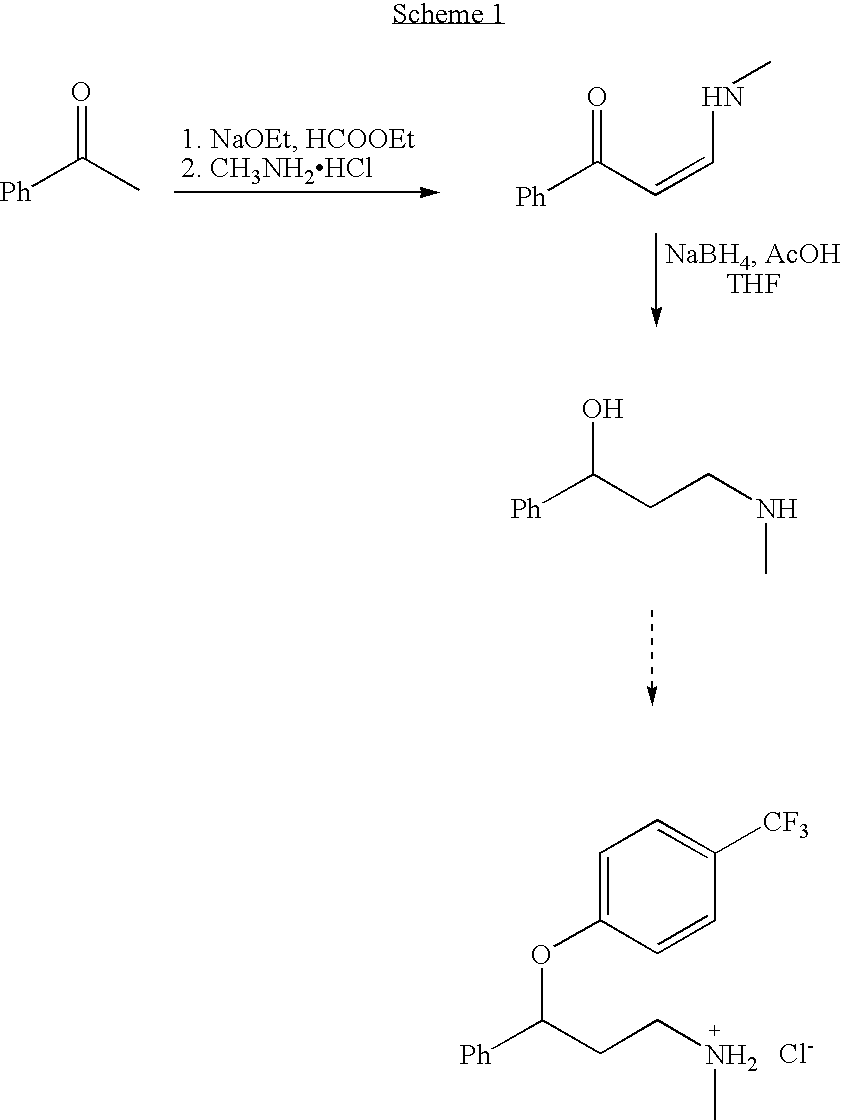Synthesis of 3-aminomethyl-1-propanol, a fluoxetine precursor
a technology of fluoxetine and 3-aminomethyl-1-propanol, which is applied in the field of chemical synthesis, can solve the problems of low overall yield
- Summary
- Abstract
- Description
- Claims
- Application Information
AI Technical Summary
Problems solved by technology
Method used
Image
Examples
example 1
Preparation of 3-(Methylamino)-1-phenyl-2-propen-1-one
3-(Methylamino)-1-phenyl-2-propen-1-one was synthesized in two steps with a 70% overall yield by the Claisen condensation of acetophenone with ethyl formate followed by the treatment of the intermediate benzoylacetaldehyde sodium salt with methylamine hydrochloride according to a Scheme 2 (see Chatterjee and Rudorf, 1998 for a general description of various reactions). The crude benzoylacetaldehyde sodium salt was treated with 5 M aqueous methylamine hydrochloride (5 equivalents); the yellow crystals of 3-(Methylamino)-1-phenyl-2-propen-1-one, collected after 2 days, were spectrally pure (85% yield).
example 2
Reduction of 3-(Methylamino)-1-phenyl-2-propen-1-one with NaBH4 in HOAc.
Acetic acid was used instead of methanol in combination with sodium borohydride under mild conditions for the reduction of 3-(methylamino)-1-phenyl-2-propen-1-one. Sodium borohydride (6 equivalents) was slowly added to a 0.25 M solution of 3-(methylamino)-1-phenyl-2-propen-1-one (Formula 3), in glacial acetic acid at 5-10° C. after stirring for 3 hours at room temperature followed by the usual work-up, the target aminoalcohol was isolated with a 77% yield (Table 1, entry 1). The effectiveness of this method may be due to the enhanced activity of both carbonyl and azomethyne groups under acidic conditions.
In a particular example, NaBH4 (800 mg, 21.0 mmol) was added in portions to a vigorously stirred solution of 3-(methylamino)-1-phenyl-2-propen-1-one (600 mg, 3.7 mmol) in glacial HOAc (15 mL) over a period of 30 min at 5-10° C. The reaction mixture was stirred for another 30 min at the same temperature, and then...
example 3
Preparation of Fluoxetine Free Base
To a 3.0 L round bottom flask is added 24.5 g (0.148 mol) of the aminoalcohol and this is dissolved in 215 mL of DMSO. To this solution is added 5.72 g (0.238 mol) of sodium hydride (washed with hexanes). The solution is heated to 60° C. for 1 hour. To this dark orange solution is added 50 mL of 4-chlorobenzotrifluoride (0.374 mol). The reaction mixture is heated to 115° C. for 6 hours. The reaction is allowed to cool to room temperature and then 1.0 L of water is added to quench the reaction. The reaction mixture is extracted with ethyl ether (2 times 500 mL), followed by two extractions using toluene (2 times 500 mL). The organic layers are combined and washed twice with brine. The aqueous layer is separated and the organic layer dried, filtered and rotoevaporated to yield 60.3 g of crude material. This crude material was purified by column chromatography (silica gel) using 5% methanol:methylene chloride as the eluent. Yield of pure fluoxetine fr...
PUM
| Property | Measurement | Unit |
|---|---|---|
| temperature | aaaaa | aaaaa |
| temperature | aaaaa | aaaaa |
| temperature | aaaaa | aaaaa |
Abstract
Description
Claims
Application Information
 Login to View More
Login to View More - Generate Ideas
- Intellectual Property
- Life Sciences
- Materials
- Tech Scout
- Unparalleled Data Quality
- Higher Quality Content
- 60% Fewer Hallucinations
Browse by: Latest US Patents, China's latest patents, Technical Efficacy Thesaurus, Application Domain, Technology Topic, Popular Technical Reports.
© 2025 PatSnap. All rights reserved.Legal|Privacy policy|Modern Slavery Act Transparency Statement|Sitemap|About US| Contact US: help@patsnap.com



